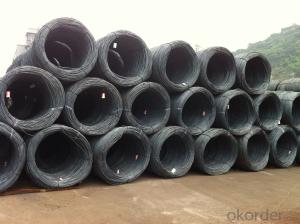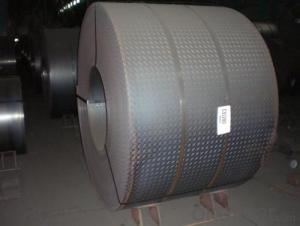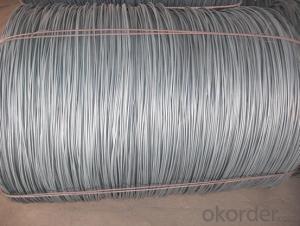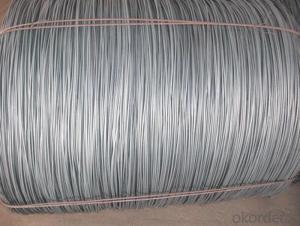Wholesale Products China inner wedges for 0.6" pc strand
- Loading Port:
- Tianjin
- Payment Terms:
- TT OR LC
- Min Order Qty:
- 50 m.t.
- Supply Capability:
- 50000 m.t./month
OKorder Service Pledge
Quality Product, Order Online Tracking, Timely Delivery
OKorder Financial Service
Credit Rating, Credit Services, Credit Purchasing
You Might Also Like
Quick Details
Steel Grade: High carton steel wire 82B
Standard: BS
Wire Gauge: 1*7 - 15.2mm
Place of Origin: Tianjin, China (Mainland)
Type: Drawn Wire
Application: Construction
Alloy Or Not: Non-alloy
Special Use: Cold Heading Steel
Model Number: 1*7-15.2mm
- Commodity: Prestressed Concrete Steel Strand
Strand diameter: 15.2mm
Steel area: 143.4㎡
Unit mass: 1126kg/km
Lay Direction: Left
low relaxation: 3.5%1000h
at Yield strength (1%Ex): 234.6KN
Breaking strength: 260.7KN
Elongation in(Lo>24''/610m: 5.0
Modulus of elasticity: 199
Packaging & Delivery
| Packaging Details: | Packing: In soft coils, water proof paper inner, white color hessian (or. P.P) cloth outer Coil Weight: around 2.500 kg or negotiation Cargo: to be stuffed in 25*20GP containers (No more than 25MTS / container) |
|---|---|
| Delivery Detail: | 20 days after confirm the order |
| Wholesale Products China inner wedges for 0.6" pc strand |
Product Pictures of inner wedges for 0.6" pc strand
- Q:How does the corrosion resistance of steel wire rod vary with different wire drawing processes?
- The corrosion resistance of steel wire rod may vary depending on the specific wire drawing processes utilized. Wire drawing involves pulling the steel wire rod through a series of dies to decrease its diameter and increase its length. One crucial element that impacts corrosion resistance is the surface finish of the wire after the drawing process. Different surface finishes, such as bright, galvanized, or coated, can be achieved through wire drawing processes. These surface finishes act as a barrier between the steel wire rod and the corrosive environment, providing additional protection against corrosion. Another factor that affects corrosion resistance is the reduction in diameter during the wire drawing process. As the diameter decreases, the wire's surface area increases, making it more susceptible to corrosion. However, this can be addressed by selecting appropriate wire drawing processes that ensure a consistent and uniform reduction in diameter, as well as by utilizing corrosion-resistant coatings or treatments. Furthermore, the choice of wire drawing lubricants and cooling methods can impact the corrosion resistance of the steel wire rod. Proper lubrication reduces friction and minimizes surface defects and potential corrosion sites. Effective cooling methods prevent overheating during the drawing process, which can also affect corrosion resistance. To summarize, various factors related to the wire drawing process influence the corrosion resistance of steel wire rod. These factors include the surface finish, reduction in diameter, lubrication, and cooling methods employed. By carefully selecting and optimizing these factors, manufacturers can enhance the corrosion resistance of steel wire rod, ensuring its long-term durability and performance in corrosive environments.
- Q:What are the common production processes for hydrogen-coated steel wire rod?
- The common production processes for hydrogen-coated steel wire rod typically include pickling, annealing, coating, and wire drawing.
- Q:How is steel wire rod used in the manufacturing of wire forms for household appliances?
- Steel wire rod is an essential component in the manufacturing of wire forms for household appliances. These wire forms are used in a wide range of applications, such as heating elements, fan guards, racks, and shelves. The process begins with the production of steel wire rod, which is a long, cylindrical piece of steel. This rod undergoes several manufacturing processes before it is transformed into wire forms. The first step is drawing, where the steel wire rod is pulled through a series of dies to reduce its diameter and increase its length. This process ensures that the wire has the desired thickness and strength. Once the wire is drawn, it is further processed to create various wire forms. For example, in the case of heating elements, the wire is coiled into a specific shape and size. This coiled wire is then typically passed through a heating process to improve its durability and resistance to heat. In the case of fan guards, the steel wire rod is bent and shaped into a circular or square pattern, forming a protective barrier around the fan blades. These wire forms are designed to prevent any objects or fingers from coming into contact with the blades while the fan is running. Similarly, for racks and shelves, the steel wire rod is bent and welded to create a sturdy and durable structure. These wire forms provide support and organization for various household appliances, such as ovens, refrigerators, and dishwashers. Overall, steel wire rod is a crucial material in the manufacturing of wire forms for household appliances. Its strength, flexibility, and durability make it an ideal choice for creating a wide range of wire forms that are essential for the functioning and safety of household appliances.
- Q:How is steel wire rod used in the manufacturing of wire rope cables?
- Steel wire rod is used in the manufacturing of wire rope cables as it serves as the raw material for producing the individual wires that make up the cable. The wire rod is first drawn through a series of dies to reduce its diameter and increase its length, resulting in a thinner and longer wire. These individual wires are then twisted or braided together to form the strands of the wire rope cable. The strength and durability of steel wire rod make it an ideal choice for manufacturing wire rope cables that are used in various industries such as construction, mining, and transportation.
- Q:What are the common industry standards for steel wire rod manufacturers?
- The common industry standards for steel wire rod manufacturers typically include specifications related to the chemical composition, mechanical properties, dimensional accuracy, surface quality, and packaging requirements of the wire rods. These standards are set by organizations such as the American Society for Testing and Materials (ASTM), International Organization for Standardization (ISO), and national or regional standards bodies. Compliance with these standards ensures the quality and consistency of steel wire rod products in the market.
- Q:What are the requirements for steel wire rod used in cable-stayed bridge wire strands?
- The requirements for steel wire rod used in cable-stayed bridge wire strands are typically stringent due to the critical nature of these components in ensuring the safety and structural integrity of the bridge. Here are some of the key requirements for steel wire rod used in cable-stayed bridge wire strands: 1. Material Composition: The steel wire rod must be made from high-quality, high-strength steel with specific chemical composition requirements. This is to ensure the wire's ability to withstand the loads and stresses it will experience in the cable-stayed bridge. 2. Tensile Strength: The wire rod must have a minimum tensile strength that meets the design requirements of the cable-stayed bridge. This ensures that it can withstand the tension forces exerted on it without deformation or failure. 3. Ductility: The steel wire rod must possess sufficient ductility to allow for bending and shaping without fracturing or losing its strength properties. This is important during the fabrication and installation processes of the wire strands. 4. Uniformity and Consistency: The wire rod should have uniform and consistent material properties throughout its length. This is crucial to ensure consistent performance and behavior of the wire strands under various loading conditions. 5. Surface Quality: The surface of the wire rod must be smooth and free from defects such as cracks, scratches, or other surface irregularities. This is necessary to prevent stress concentration points or potential failure initiation sites. 6. Dimensional Accuracy: The wire rod should meet specific dimensional tolerances to ensure proper fit and compatibility with the cable-stayed bridge design. This includes diameter, roundness, and straightness requirements. 7. Corrosion Resistance: The wire rod must possess good corrosion resistance properties to withstand exposure to environmental conditions, including moisture, humidity, and chemicals. This helps to ensure the long-term durability and safety of the wire strands. 8. Certification and Testing: The steel wire rod used in cable-stayed bridge wire strands must be produced by reputable manufacturers and should be accompanied by relevant certifications and test reports. These documents provide assurance that the wire rod meets the specified requirements and has undergone necessary quality control measures. It is important to note that specific project requirements and design standards may vary, and the above requirements may not be exhaustive. Consulting the applicable design codes and specifications for cable-stayed bridges is essential to ensure compliance with the project-specific requirements.
- Q:What are the main factors influencing the choice of steel wire rod order warranty claims process?
- The choice of the warranty claims process for steel wire rod orders can vary depending on several factors. Firstly, the quality of the wire rod plays a significant role in determining how often and how straightforward the warranty claims process will be. If the wire rod meets the required standards and is of high quality, there may be fewer claims and a simpler process. Conversely, if the wire rod has inherent flaws or defects, there is a higher likelihood of warranty claims, resulting in a more complex process. Secondly, the terms and conditions of the warranty provided by the supplier or manufacturer can greatly impact the choice of the warranty claims process. The duration, coverage, and any limitations or exclusions of the warranty can influence decision-making. A comprehensive warranty with a reputable supplier can instill confidence in the buyer, making them more likely to choose that specific claims process. Additionally, the availability and efficiency of customer support and after-sales service are crucial factors in deciding the warranty claims process. Responsive and prompt customer support can expedite the claims process, provide guidance, and address any concerns or queries from the buyer. This level of support significantly influences the choice of the warranty claims process, ensuring a smoother and more satisfactory experience. Furthermore, the reputation and track record of the supplier or manufacturer also impact decision-making. Buyers are more likely to select a warranty claims process from a trustworthy supplier with a history of promptly and fairly honoring warranty obligations. This factor provides peace of mind and increases confidence in choosing a particular claims process. Lastly, the cost-effectiveness and convenience of the warranty claims process can play a role in the decision. If the process is affordable and convenient for the buyer, they may be more inclined to choose that specific claims process. This includes factors such as the ease of filing a claim, the time taken for resolution, and any associated costs or deductibles. Overall, the key factors influencing the choice of warranty claims process for steel wire rod orders are the quality of the product, the terms and conditions of the warranty, the availability of customer support, the reputation of the supplier, and the cost-effectiveness and convenience of the process.
- Q:What are the corrosion resistance requirements for steel wire rod used in marine wire ropes?
- The corrosion resistance requirements for steel wire rod used in marine wire ropes are typically high due to the harsh and corrosive environment of the marine industry. Since wire ropes are commonly exposed to seawater, saltwater, and other corrosive agents, the steel wire rod used in their construction must possess excellent resistance to corrosion. The primary corrosion resistance requirement for steel wire rod in marine wire ropes is the ability to withstand and resist the corrosive effects of saltwater. Saltwater contains high levels of chloride ions, which are particularly aggressive and can cause accelerated corrosion of metals. Therefore, the steel wire rod used in marine wire ropes must have a high resistance to chloride-induced corrosion. In addition to chloride corrosion, steel wire rod used in marine wire ropes must also exhibit resistance to general corrosion caused by other environmental factors such as moisture, oxygen, and temperature fluctuations. The wire rod should have a protective coating or be made from a corrosion-resistant alloy to prevent or minimize general corrosion. Furthermore, the steel wire rod should also demonstrate resistance to pitting corrosion, which is localized corrosion that can occur in the presence of certain contaminants or due to surface imperfections. Pitting corrosion can lead to the formation of small holes or pits on the wire surface, reducing its strength and compromising the integrity of the wire rope. To meet these corrosion resistance requirements, stainless steel wire rod is commonly used in marine wire ropes. Stainless steel alloys, such as AISI 316 and AISI 316L, are renowned for their excellent resistance to chloride-induced corrosion, general corrosion, and pitting corrosion. These alloys contain a higher percentage of chromium, which forms a passive oxide layer on the surface of the wire, protecting it from corrosive attack. In conclusion, the corrosion resistance requirements for steel wire rod used in marine wire ropes are high, necessitating resistance to chloride-induced corrosion, general corrosion, and pitting corrosion. Stainless steel alloys, such as AISI 316 and AISI 316L, are commonly used to meet these requirements due to their excellent corrosion resistance properties.
- Q:What are the different types of corrosion resistance tests conducted on steel wire rod?
- Steel wire rods commonly undergo several corrosion resistance tests to determine their ability to withstand corrosion in different environments. These tests include: 1. Salt Spray Test: In this test, the wire rod is exposed to a continuous salt spray environment. It is placed in a chamber where it undergoes misting with a saline solution. The test measures the time it takes for the wire rod to exhibit signs of corrosion, such as the formation of rust. 2. Humidity Test: This test exposes the wire rod to a high humidity environment for a specific duration. The humidity level is controlled, and the wire rod is examined for any indications of corrosion, such as surface discoloration or oxidation. 3. Cyclic Corrosion Test: This test subjects the wire rod to repeated cycles of various corrosive conditions, including salt spray, humidity, and dry heat. The rod is exposed to these conditions in a controlled manner, and its resistance to corrosion is evaluated based on the appearance and extent of corrosion after each cycle. 4. Electrochemical Corrosion Test: This test utilizes electrochemical techniques to measure the corrosion potential and corrosion current of the wire rod. The rod is immersed in a corrosive solution, and its response to an applied electrical potential is assessed. This test provides valuable insights into the corrosion behavior and performance of the wire rod. 5. Acid Resistance Test: The acid resistance test assesses the wire rod's ability to resist corrosion caused by acids. The rod is immersed in an acidic solution for a specified period, and the extent of corrosion is determined by measuring weight loss or examining surface appearance. 6. Pitting Corrosion Test: Pitting corrosion is a localized and harmful form of corrosion. This test exposes the wire rod to a corrosive environment that promotes pitting corrosion. After exposure, the rod is inspected visually or under a microscope to identify the presence and extent of pits. These examples illustrate the different corrosion resistance tests conducted on steel wire rods. Each test provides valuable information about the rod's ability to withstand corrosion in specific conditions, ensuring its suitability for various applications.
- Q:How is steel wire rod used in the production of wire mesh for sieving?
- Steel wire rod is a crucial component in the production of wire mesh for sieving. The wire rod is first processed through a series of manufacturing steps to transform it into a suitable material for wire mesh production. This includes drawing the rod through a die to reduce its diameter and increase its length, resulting in a thin and elongated wire. Once the wire rod has been transformed into wire, it is then woven or welded together to create wire mesh. Wire mesh is a grid-like structure with evenly spaced intersecting wires, forming a pattern of uniform openings. This mesh is designed to efficiently filter and separate particles based on their size. In the production of wire mesh for sieving, the steel wire rod is typically used to create the woven wire mesh. The wire is woven together using various weaving techniques, such as plain weave, twill weave, or Dutch weave, depending on the desired mesh characteristics. The wire rod's properties, such as its strength, flexibility, and resistance to corrosion, play a vital role in the quality and durability of the wire mesh. The wire rod's strength ensures that the wire mesh can withstand the tension and stress it may encounter during sieving operations. Additionally, the flexibility of the wire allows the mesh to be easily shaped and manipulated into various sizes and configurations to meet specific sieving requirements. Furthermore, the steel wire rod's resistance to corrosion prevents the wire mesh from deteriorating when exposed to moisture or harsh environmental conditions. This corrosion resistance is particularly important when wire mesh is used in applications where it comes into contact with liquids or substances that could potentially cause damage. Overall, the steel wire rod is an essential material in the production of wire mesh for sieving. Its transformation into wire and subsequent weaving or welding processes enable the creation of durable, reliable, and efficient wire mesh, which is widely used in various industries for sieving and separating particles of different sizes.
1. Manufacturer Overview |
|
|---|---|
| Location | |
| Year Established | |
| Annual Output Value | |
| Main Markets | |
| Company Certifications | |
2. Manufacturer Certificates |
|
|---|---|
| a) Certification Name | |
| Range | |
| Reference | |
| Validity Period | |
3. Manufacturer Capability |
|
|---|---|
| a)Trade Capacity | |
| Nearest Port | |
| Export Percentage | |
| No.of Employees in Trade Department | |
| Language Spoken: | |
| b)Factory Information | |
| Factory Size: | |
| No. of Production Lines | |
| Contract Manufacturing | |
| Product Price Range | |
Send your message to us
Wholesale Products China inner wedges for 0.6" pc strand
- Loading Port:
- Tianjin
- Payment Terms:
- TT OR LC
- Min Order Qty:
- 50 m.t.
- Supply Capability:
- 50000 m.t./month
OKorder Service Pledge
Quality Product, Order Online Tracking, Timely Delivery
OKorder Financial Service
Credit Rating, Credit Services, Credit Purchasing
Similar products
New products
Hot products
Hot Searches
Related keywords





























